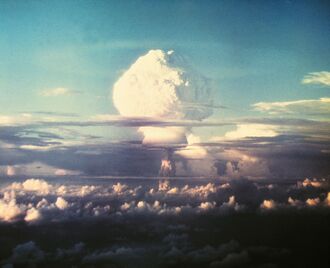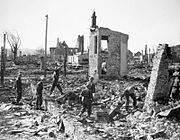1953 Palheim explosion: Difference between revisions
mNo edit summary |
mNo edit summary |
||
| Line 17: | Line 17: | ||
}} | }} | ||
On 15 April 1953, a {{wpl|Boeing B-47 Stratojet|B-47}} crashed at the [[Palheim Air Base]] near the town of [[Palheim]] in [[Sovar]] caused the accidental detonation of one of the stored weapons at the site. The explosion which occurred approximately 5 kilometres outside of the settlement killed most of it's inhabitants along with | On 15 April 1953, a {{wpl|Boeing B-47 Stratojet|B-47}} crashed at the [[Palheim Air Base]] near the town of [[Palheim]] in [[Sovar]] caused the accidental detonation of one of the stored weapons at the site. The explosion which occurred approximately 5 kilometres outside of the settlement killed most of it's inhabitants along with all of the personnel on the Air Base | ||
The explosion led to the [[Rythenean Sovar|Sovarese government]] ordering an inquiry into the disaster which found several major structural and technical faults with the site's design and the lack of communication between the Site's operators and the residents of Palheim. The explosion was felt in [[Sulastad]] which was 40 kilometres south of Palheim. | The explosion led to the [[Rythenean Sovar|Sovarese government]] ordering an inquiry into the disaster which found several major structural and technical faults with the site's design and the lack of communication between the Site's operators and the residents of Palheim. The explosion was felt in [[Sulastad]] which was 40 kilometres south of Palheim. | ||
Revision as of 15:09, 29 December 2020
This article is incomplete because it is pending further input from participants, or it is a work-in-progress by one author. Please comment on this article's talk page to share your input, comments and questions. Note: To contribute to this article, you may need to seek help from the author(s) of this page. |
 The Mushroom cloud shortly after the explosion taken from a commercial plane | |
| Date | 15 April 1953 |
|---|---|
| Time | 10:33 UTC |
| Venue | Palheim Bay |
| Location | Palheim, Eysturamt, Sovar |
| Type | Nuclear explosion |
| Cause | Accidental nuclear detonation |
| Deaths | 192 |
| Non-fatal injuries | 56 |
On 15 April 1953, a B-47 crashed at the Palheim Air Base near the town of Palheim in Sovar caused the accidental detonation of one of the stored weapons at the site. The explosion which occurred approximately 5 kilometres outside of the settlement killed most of it's inhabitants along with all of the personnel on the Air Base
The explosion led to the Sovarese government ordering an inquiry into the disaster which found several major structural and technical faults with the site's design and the lack of communication between the Site's operators and the residents of Palheim. The explosion was felt in Sulastad which was 40 kilometres south of Palheim.
In the aftermath of the disaster the Sovarese government declared a state of emergency. Rescue teams were hampered in their efforts by bad weather and radiation from the explosion. In total 192 people were killed, primarily residents of Palheim where 95% of all buildings were either severely damaged or completely destroyed. 60 people at the Air Base were killed immediately including 3 onboard the plane. Only 63 residents of Palheim survived. The town was preserved by the Sovarese Government and is now part of the Palheim National park.
Background
Palheim air base
Explosion
B-47 Crash
Explosion and aftermath
About 15 seconds after the plane impacted the Storage Igloo, one of the nuclear bombs inside was detonated. The air base was destroyed immediately and everyone on the base was killed. In Palheim many residents witnessed the explosion and some had been able to take shelter quickly. Students at the town's school were able to seek shelter under their desks. The school would survive the blast and most inside would survive. Most of the casualties came from those who had been in homes constructed next to the coast. Every building on Palheim's coast was destroyed in the explosion.
The explosion generated a 10 metre high Tsunami which struck Palheim two minutes after the explosion killing dozens survivors who were unable to flee. Several fishing vessels which had been in Palheim bay were carried out to sea. Two fishermen would survive the Tsunami and explosion would later recall a second smaller wave from subsequent landslides caused by the explosion.
Much of the town's centre was destroyed in the explosion and caught fire shortly after. Most of the remaining buildings on the town's east side burned down trapping some survivors. The fires from Palheim would start a massive forest fire which would eventually become the largest in Sovarese history.
Most of the survivors of the explosion were brought to Palheim's school which was turned into an emergency medical facility for the injured. The Sovarese Home guard was sent to the town and arrived at 20:20 due to the damaged infrastructure in the area. According to Photojournalist Peter Úlvurson "the whole village looked like a giant had crushed it with his thumb."
The town's survivors were evacuated on 16 April, many were transported to the Sulastad National Hospital. The uninjured were brought to Vagnstad which received some minor damage from the Tsunami. One of the survivors, Nansý Astradóttir, gave the first interview following the disaster. In her interview she claimed to have seen a bright flash and then a loud crash which threw her across the room she was in. Astradóttir's building didn't collapse and she along with her young child were able to escape uninjured.
The mayor along with many local figures were killed in the explosion which hampered coordination efforts. Only one survivor would be pulled from the rubble of the town in the days following the disaster. By 1 May it was declared that everyone who wasn't accounted for had most likely died in the explosion. The final bodies of the explosion were recovered in 1955. The bodies of the victims were buried in a mass grave outside of the town.
Radiation from the explosion was blown out to sea by the gale-force winds the area experienced shortly after the explosion and dissipated in the following days.
Yield
Cause
Casualties
192 people were killed and 56 people were injured. All of the victims were residents of Palheim and the surrounding area. Only 102 bodies were recovered and it is estimated that the remaining victims had been incinerated or swept out to sea in the tsunami. Several of the dead would survive the explosion but die of their wounds a short time later. All 3 flight crew members onboard the B-47 were likely killed on impact with the storage igloo. The remaining 57 at the air base were all killed in the ensuing explosion.
It is estimated that 30% of all survivors in Palheim would later die due to radiation poisoning and cancer.
Damage
Investigation
Relief operations
Reactions
The Sovarese government declared a state of emergency in the region in the aftermath of the explosion. The Sovarese Prime Minister would visit the site a week after the explosion and pay his respects to the dead.
Conspiracy theories
- A widespread theory about the cause of the explosion was sabotage by Sovarese nationalists. The SFS, a separatist terrorist organisation had been responsible behind several small scale bombings before the explosion. In 1974, Fríálvur Viljamson, the leader of the Socialist Party, claimed that the SFS had some role in the crash of the B-47 at the air base. The leader of the SFS at the time, Øssur Danjalson, claimed in an interview in 1975, that the SFS were not involved in the explosion. Danjalson called the theories 'childish' and 'disrespectful'. Viljamson would apologise for his comments shortly after this.
In popular culture
The explosion is the main focus of the 2020 movie Tann enda which focuses on the survival of several of the town's residents in the immediate aftermath of the explosion. The film has been criticised for dramatising the event.
